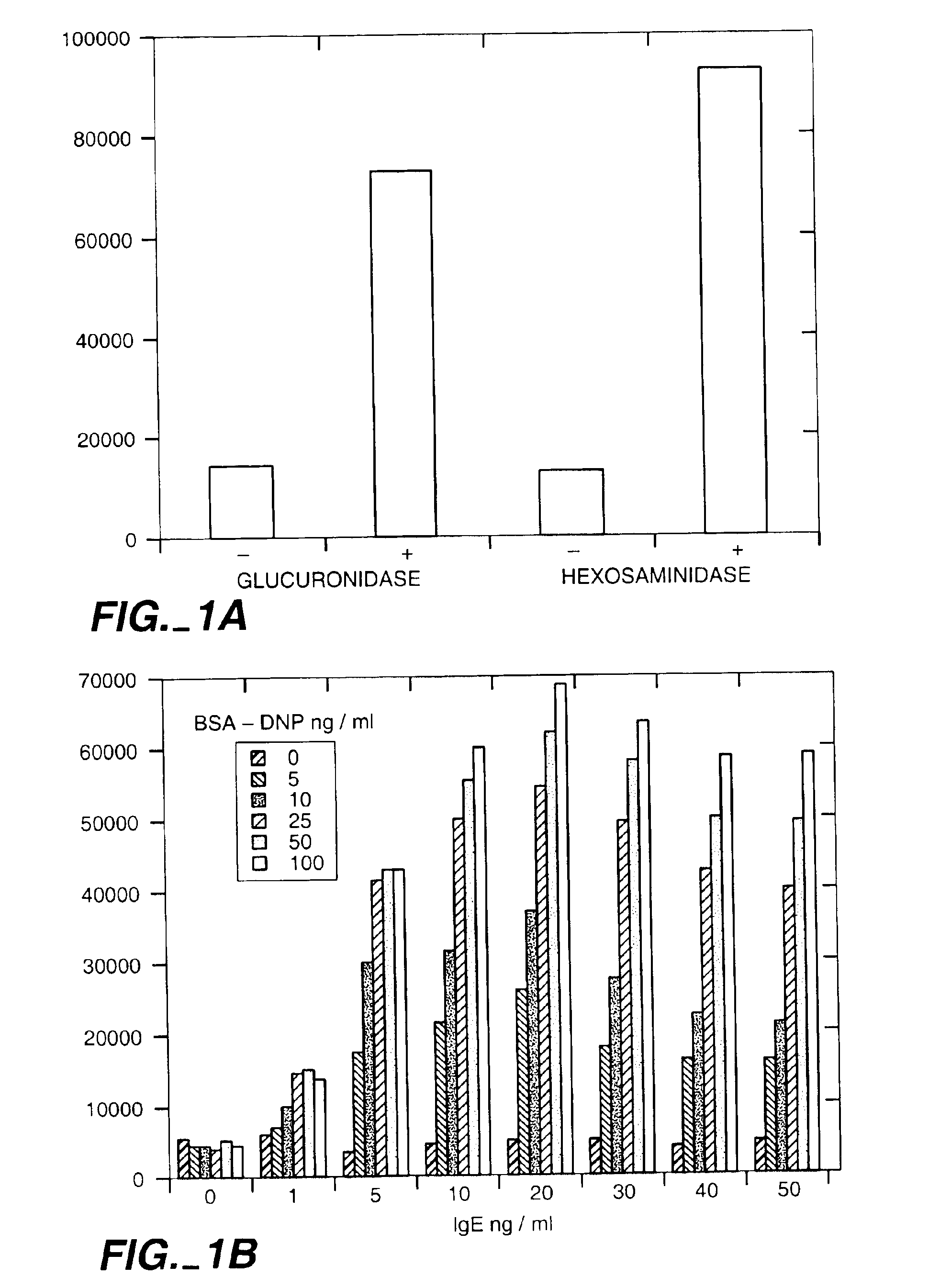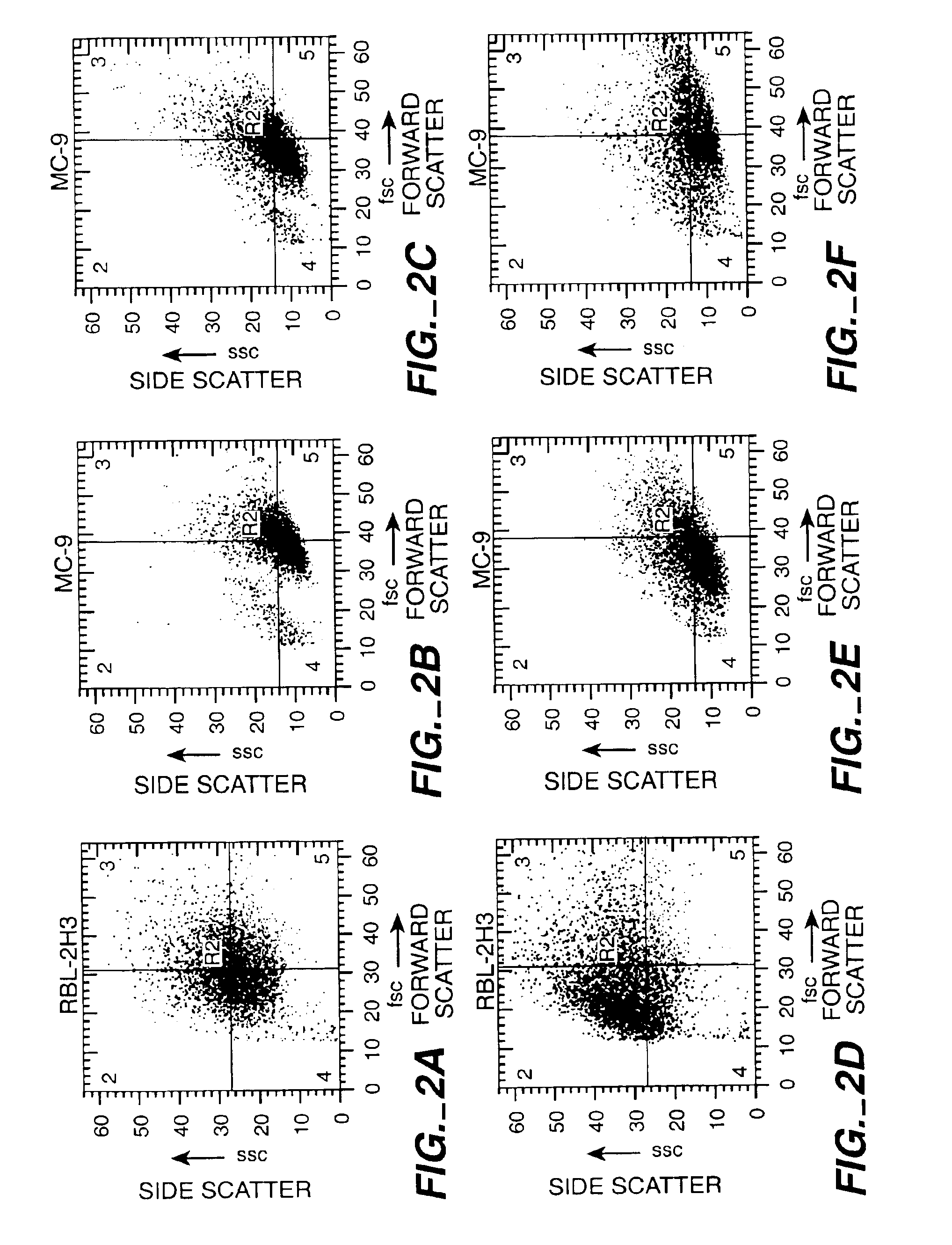Multiparameter FACS assays to detect alterations in exocytosis
a technology of exocytosis and facs assays, applied in the field of multiparameter facs assays to detect exocytosis alterations, can solve the problems of limited approach and limited allergy therapy
- Summary
- Abstract
- Description
- Claims
- Application Information
AI Technical Summary
Benefits of technology
Problems solved by technology
Method used
Image
Examples
example 1
Population Based Exocytic Enzyme Activity Measurements
[0134]Materials: All chemicals were obtained from Sigma Chemical Co. Dyes and glucuronide were obtained from Molecular Probes, Inc. Cell lines MC-9 and RBL-2H3 were obtained from American Type Culture Collection (ATCC). Cell culture reagents were obtained from Fisher Scientific and molecular biology reagents from Clontech Inc.
[0135]Cell Culture: MC-9 cells were maintained as suspension cultures in flasks in media consisting of DMEM with L-arginine (116 mg / ml), L-asparagine (36 mg / ml), sodium pyruvate (1 mM), non-essential amino acids (0.1 mM), folic acid (6 mg / ml), 2-mercaptoethanol (0.05 mM), L-glutamine (2 mM), heat inactivated fetal bovine serum (10%), and 10% T-stim conditioned media (Collaborative Research, Inc.). The cells were kept at a density of between 0.25 and 2×106 / ml. Experiments were only conducted on cells which were greater than 95% viable as determined by trypan blue exclusion. RBL-2H3 cells were maintained as ad...
example 2
Mast Cell Exocytic Light Scatter Changes
[0140]The cells were prepared as described in Example 1, and light scatter properties were determined.
[0141]Results: The results are shown in FIG. 2. Light scatter changes observed on the flow cytometer (side scatter vs. forward scatter) are plotted as bivariate histograms for RBL-2H3 cells (A, D) and MC-9 cells (B, C, E, F). Cells were stimulated with the ionophore A23187 (0.5 ug / ml) and observed at various timepoints [minutes (A, C), 5 minutes (E), 10 minutes (D), and 30 minutes (B, F)]. Time dependent scatter changes are evident in both cell lines with significant changes occuring during the first 10 minutes which represents the major bolus of exocytosis in these cells.
example 3
Styryl Dyes Detect Mast Cell Exocytosis by FACS
[0142]Styrl Dye Straining: The cells were prepared as described above. Styryl dyes (FM1-43 or FM4-64; Molecular Probe s, Inc.) were diluted to a final concentration of 250 mM in MT and were incorporated into the stimulation buffer (see Example 1). After the stimulation protocol the cells were spun down, aspirated and resuspended in fresh ice cold MT. The cells were then ready for analysis in the flow cytometer (see Example 1).
[0143]Results: The results are shown in FIG. 3. MC-9 cells were stimulated (blue=DMSO, red=2 μM ionomycin) in the presence either FM 4-64 (A, B) or FM 1-43 (C,D,E). A) FM 4-64 labeled cells detected in the flow cytometer in fluorescence channel 1. B) FM 4-64 labeled cells detected in the flow cytometer in fluorescence channel 3. C) FM 1-43 labeled cells detected in the flow cytometer in fluorescence channel 1. D) FM 1-43 labeled cells detected in the flow cytometer in fluorescence channel 3. There is a clear stimul...
PUM
| Property | Measurement | Unit |
|---|---|---|
| concentration | aaaaa | aaaaa |
| concentration | aaaaa | aaaaa |
| concentration | aaaaa | aaaaa |
Abstract
Description
Claims
Application Information
 Login to View More
Login to View More - R&D
- Intellectual Property
- Life Sciences
- Materials
- Tech Scout
- Unparalleled Data Quality
- Higher Quality Content
- 60% Fewer Hallucinations
Browse by: Latest US Patents, China's latest patents, Technical Efficacy Thesaurus, Application Domain, Technology Topic, Popular Technical Reports.
© 2025 PatSnap. All rights reserved.Legal|Privacy policy|Modern Slavery Act Transparency Statement|Sitemap|About US| Contact US: help@patsnap.com



